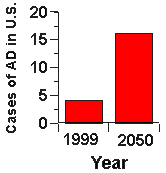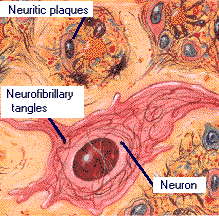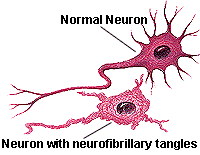Neurodegenerative pathologies
Neurodegenerative pathologies![]() are devastating diseases that not only seriously compromise health,
but also impair human personality. The most dramatic are various forms of
dementia, of which the most frequent is senile dementia or Alzheimer's disease.
In an Alzheimer patient, the progressive degeneration of several
neurons
are devastating diseases that not only seriously compromise health,
but also impair human personality. The most dramatic are various forms of
dementia, of which the most frequent is senile dementia or Alzheimer's disease.
In an Alzheimer patient, the progressive degeneration of several
neurons![]() occurs, particularly in some areas of the cerebral cortex where typical neuropathological hallmarks are the
neurofibrillary tangles
occurs, particularly in some areas of the cerebral cortex where typical neuropathological hallmarks are the
neurofibrillary tangles![]() and the
neuritic plaques
and the
neuritic plaques![]() , mainly
made up of a modified form of the amyloid protein (Fig. 1).
, mainly
made up of a modified form of the amyloid protein (Fig. 1).
|
Fig. 1: Images from NIA (National
Institute on Aging). |
Disease symptoms start with memory impairment and evolve later with dramatic alterations of intellectual ability and loss of control over body functions. In most cases, Alzheimer's disease becomes patent in the elderly and its incidence dramatically increases with aging: at 70 years of age, approximately 5% of the population is affected, but the percentage jumps to 25% at 85 years of age.

|
Fig. 2: Estimated progression of
cases of Alzheimer disease in the United States (millions of persons
affected). |
As demonstrated by the graph of Fig.
2, the improvement of health and living conditions, together with longer life
expectancy, unavoidably lead to an increase of Alzheimer patients, who at present
cannot be effectively treated, except with some accessory drugs. It has been
said that the disease, which tends to aggravate when health and social
conditions improve, is like a time-bomb of civilization. Perspective therapies,
so far largely theoretical,are based on the possibility to perform transplants
with young cells that could substitute those undergoing degeneration, similarly
to what has been done with some success for
Parkinson's disease![]() during the
past years.
during the
past years.

